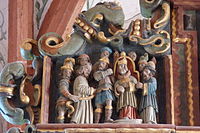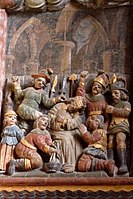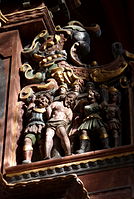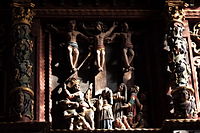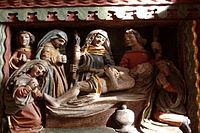Bitter suffering altar

The bitter suffering altar is a baroque carved altar on which the story of the passion of Jesus is depicted. It is located in the Mater Dolorosa pilgrimage church in Driesch, a district of Lutzerath in the Cochem-Zell district in Rhineland-Palatinate .
history
According to oral tradition, the altar was set up around 1672 in the left choir of the pilgrimage church of Driesch. There are no written documents about the carver . It is believed that the carpenter Bartholomäus Hammes from Alflen created the altar. During a renovation in 1868/69, the altar was painted gray. In 1940 Dechant Alois Breidt found the altar "in a desolate condition, badly worn by the wood worm, painted an ugly stone gray and also completely ignored in this dark corner", as he reports in the parish chronicle. In 1941/42 he had the altar restored in Karl Port's workshop in Münstermaifeld and then set up as the main altar in the right choir.
description
The altar is divided into three essays and consists of eleven relief panels on which the passion of Jesus is depicted in scenes rich in figures. The outer left panel of the first article shows Jesus and the sleeping disciples on the Mount of Olives. Jesus humbly kneels before an angel who holds a chalice in front of his eyes. The left panel of the second essay shows the arrest of Jesus and the outer panel above it of the third essay shows Jesus being presented to Caiaphas . The scenes are continued on the outer right panels. The lower panel depicts the mockery of Jesus, followed by the flagellation and on the upper panel the crowning of thorns.
The later overpainting with oil paint was removed from the lower outer panels and the original tempera painting was exposed again. Behind the scene of the Mount of Olives you can see a landscape of palm trees and rocks and a city gate to Jerusalem. The painting in the background of the mockery of Christ shows the interior of a temple with late Gothic pointed arch architecture in which a smoke offering is made.
The main scenes of the Passion occupy the center of the altar. The upper end is a scene of the carrying of the cross, on the scene below Christ is nailed to the cross.
The first and second essays are studded with winding columns decorated with vine tendrils and angel heads. The middle panels of these two essays are highlighted by larger figures. The central panel of the second essay shows Christ on the cross between the two thieves. A soldier stabs Jesus in the side with a lance, other soldiers crouch next to the mourning women at the foot of the cross and roll the dice. The middle panel of the first essay is framed by a round arch and shows the descent from the cross. The relief panel of the base shows the entombment.
literature
- Walter Pippke and Ida Leinberger: The Eifel . DuMont Buchverlag , 4th edition, Cologne 2004, ISBN 3-7701-3926-7 , p. 269.
- Alfons Wolff: The Marienkirche in Driesch Parish Lutzerath. Historical and pictorial representation . Edited by the Catholic Parish Office St. Stephanus Lutzerath, Tübingen o. J.
Web links
- Bitter suffering altar parish Lutzerath
Coordinates: 50 ° 7 '58.8 " N , 7 ° 1' 19.7" E


